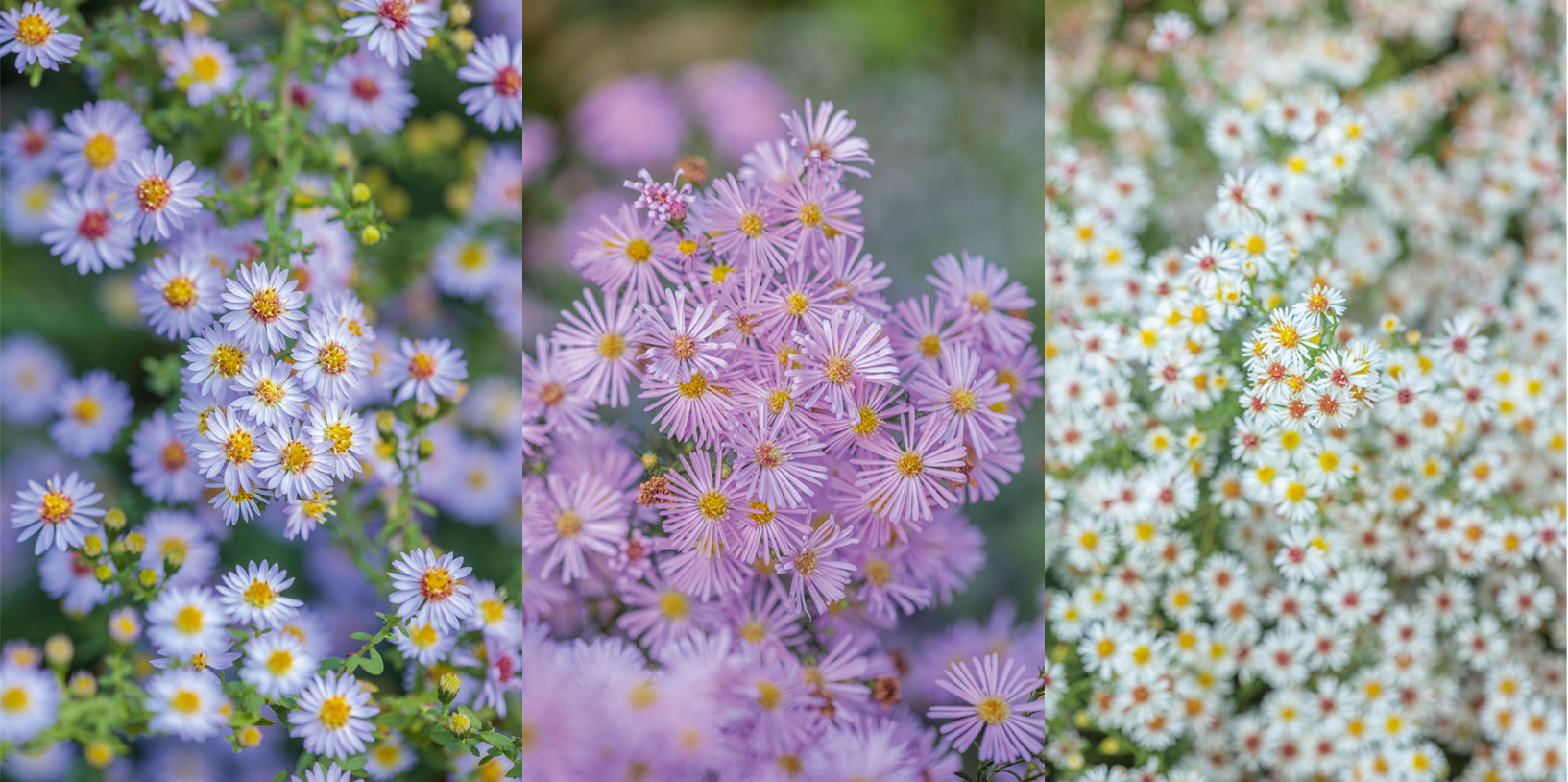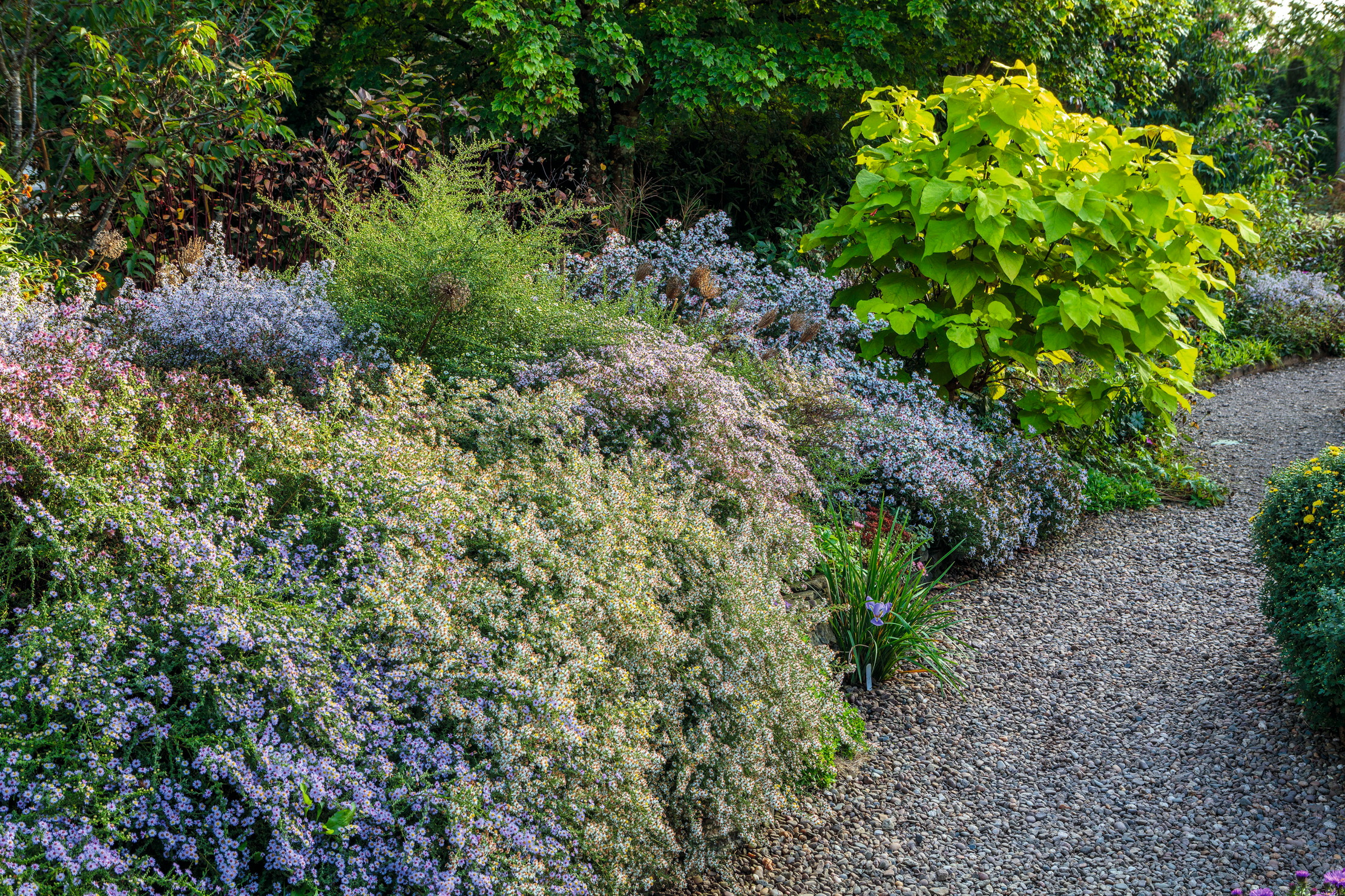Asters: what they are, which ones to try and how to grow them
These late blooming plants 'promise future spring', making them essential for any garden.

The lowering sun and shorter days are the first signs that autumn is gently creeping in. Trees and shrubs are straining to hold onto their foliage and the last of the unpicked apples are falling and rotting in the wet grass. The melancholy of the season is enlivened, however, by the final shout from boisterous dahlias, blazing orange rudbeckias and shimmering crocosmias. Joining the exuberance of this closing spectacle are pastel-coloured drifts of Michaelmas daisies, with a vigour and abundance that harks back to the benign days of early summer. The 19th-century poet Letitia Landon wrote of the way these daisies ‘call past bloom to mind, to promise future spring’.
The family is large and encompasses species from North America — stout plants with strongly coloured flowers — and low-growing forms that creep along rocky ledges in alpine areas. For many gardeners, it is the small-flowered species that is the most prized: long flowering and floriferous, with clouds of tiny star-like flowers that are full of nectar, offering a late banquet to bees and insects. The flowers are never more than half an inch wide, but produced in such profusion that the whole plant appears hung with blossom. Importantly, they shrug off the cold, wind and rain that arrive with a British autumn.
Asters to try
Symphyotrichum ericoides ‘Cinderella’
An upright cultivar about 30in tall with white flowers about ½in wide that have bright golden centres. It will tolerate dappled shade and is one of the few in the family that will grow in containers, provided the compost does not dry out
Symphyotrichum ‘Photograph’
The misty-blue flowers are perhaps the bluest of the hybrids. This is not the most vigorous plant and may take a season or two to establish itself, but it is worth growing for the intense colour of the flowers
Symphyotrichum ‘Ochtendgloren’
Exquisite houses, the beauty of Nature, and how to get the most from your life, straight to your inbox.
Although, as the name suggests, this peaks during October, the flowers appear in early September and will continue until blackened by frosts. It grows to about 4ft tall, but the stems are weak and so need staking
Symphyotrichum ‘Oktoberlicht’
The pure-white flowers bring a lightness and a freshness not usually associated with autumn. This hybrid grows to about 3ft tall and has a more open, airy habit than other members of the group. Flowering starts early in September and reaches a peak in mid October
Symphyotrichum ericoides ‘Blue Star’
The foliage resembles that of heather and is weighed down with sprays of flowers that, despite the name, are a pale-violet colour. It was introduced during the 1920s and is still popular in nurseries, a sure sign that it is a plant worth growing
Symphyotrichum lateriflorum ‘Chloé’
Arching stems about 3ft tall are packed with white flowers. The centre of the flower is yellow and turns to a dusky pink once it has been pollinated and the petals droop downwards as they age

At this time of year, there are few cut flowers that are as long-lasting or as graceful as these. William Robinson admired their ‘quiet beauty’ and recommended that they be grown for both cutting and in the garden, where they should be planted in bold clumps. He wrote that they are excellent around tall shrubs. Modern designers who are interested in plant communities value them for their late flowers and their winter structure.
For decades, Michaelmas daisies have also been known as starworts and, botanically, as asters, in reference to their star-like flowers and to the Titan Asteria, who wept on seeing a star-less sky. Where her tears fell, asters grew. With the help of DNA testing, botanists have now redistributed asters among six different genera, with most reclassified as Symphyotrichum: the simplicity and poetry of ‘aster’ replaced with a word that is almost unpronounceable. Nurseries are beginning to list plants under their new name, but, fortunately, even the most serious-minded nurserymen still speak of asters.
Symphyotrichum ericoides (the species name alludes to the similarity to heather) has spawned dozens of cultivars, all of which have narrow-petalled flowers with a golden centre. Most form mounds are about 30in tall, but the lavender-flowered ‘Yvette Richardson’ never reaches more than 18in. Her cousin ‘White Heather’, meanwhile, will grow to 4ft and its strong stems are smothered with sparkling white flowers. A prostrate form, S. ericoides var. prostratum ‘Snow Flurry’, also has white flowers and looks magnificent tumbling over a low wall or along the edges of paths.
How to grow asters
Small-flowered asters will flourish in humus-rich soils that do not dry out in the summer. They will not survive in soils that become waterlogged during the winter. Baking-hot summers and cold wet winters are the plants’ enemies
Good light is important for flowering, so choose a sunny position or the lightly dappled shade close to deciduous trees and shrubs. The more shady the situation, the fewer flowers there will be
After three or four years, the centre of the plant will begin to die out. At this point, dig up the whole clump in early spring, divide it into smaller pieces and replant. Asters quickly regain their vigour
On the whole, they are sturdy plants, but can be susceptible to powdery mildew, a fungus that appears as a white dusting on the leaves and stems. Ensuring the soil is kept moist during dry periods can help reduce mildew. Do not put diseased foliage on the compost

Although the parent of fewer cultivars, Symphyotrichum lateriflorum is a widely grown member of the genus and has a branching habit that resembles a small shrub. The young leaves are a distinctive reddish-purple and some cultivars, such as ‘Lady in Black’ and ‘Prince’, retain this colouring throughout the season. During the winter, straw-coloured flowers cling on to the twiggy stems to create an intricate tracery that is beautiful on frosty mornings. S. lateriflorum ‘Horizontalis’, as its cultivar name suggests, has sturdy horizontal branches that are crowded on the upper side with sprays of white flowers that have a dusty-pink centre. It is often grown as a hedge, most famously in the gardens at Great Dixter in East Sussex, where it billows along the edge of a path.
Bred in the 1980s for the cut-flower trade and commercially grown worldwide, Symphyotrichum pringlei ‘Monte Cassino’ is one of the few cultivars of the species. It is the familiar florists’ aster, with wiry stems that support long-lasting clouds of tiny white flowers: as good in the garden as it is in a vase.
Asters were in their heyday at the beginning of the 20th century and, as well as many cultivars, several hybrids were bred. ‘Ringdove’ is still popular, appreciated for its pale-lavender flowers and strong growth. More recently, contemporary garden designers and nurserymen have been turning their attention to the genus. Landscape designer and former nurseryman Piet Oudolf has introduced several that sit perfectly in the naturalistic landscapes he designs, where the architecture of the plant year round is as important as the flowers. ‘Poollicht’, introduced by him in the early 1990s, is worth searching out for its ice-blue flowers and solid, open structure. These new introductions may no longer be called aster, but they and their family are still the stars of the autumn garden.
John Hoyland is a renowned gardener, writer and plantsman, and is the garden adviser at Glyndebourne.

The best bulbs to plant in your gardens, pots and pathways to guarantee floods of colour next Spring
The anticipation of cheerful spring bulbs can keep the gardener going through the dull winter months. John Hoyland advises on